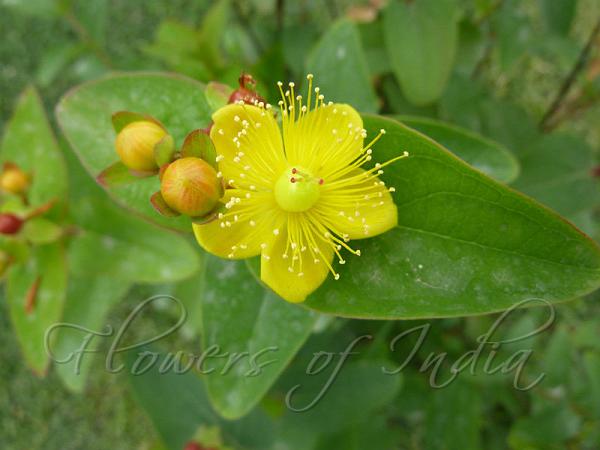|
| Tutsan |
|

|

| File size | 100246 |
| Original date | 6/16/10 3:19 PM |
| Resolution | 800 x 600 |
| Flash | Flash did not fire, auto |
| Focal length | 4.1mm |
| Exposure time | 1/125s |
| Aperture | 4.0 |
| Focus Distance | |
| Metering Mode | Multi-segment |
| Camera make | Panasonic |
| Camera model | DMC-ZS3 |
| Sensor type | OneChipColorArea |
|
|
|
|
Photo: |
Botanical name: Hypericum androsaemum Family: Hypericaceae (St John's Wort family)
Tutsan is a unique in that no other St John's Wort has berries or is a
shrub with substantial woody stems and branches. The others may be
somewhat woody at the base but are much smaller plants with flowers less
than 1.8 cm in diameter. This plant is is a shrub, 50-90 cm tall, native
to open woods and hillsides in Eurasia. Flowers
are 1.8-2.8 cm in diameter. Sepals are unequal. Stem has 2 raised lines.
Fruit turns black when ripe. The common name tutsan appears to be a
corruption of toute saine literally meaning all-healthy. This is probably
in reference to its healing properties.
Medicinal uses: The leaves are used applied to wounds, and as a
stomachich. Nicholas Culpeper, in his 1653 publication Culpeper's Complete
Herbal, says "Tutsan purgeth choleric humours ... both to cure sciatica
and gout, and to heal burnings by fire." It will also stop bleeding and
heal wounds and sores. Apparently it works just as well if it swallowed or
used as a salve or ointment. The berries which turn from white/green, to
red, to black are poisonous.
The leaves are used applied to wounds, and as a
stomachich. Nicholas Culpeper, in his 1653 publication Culpeper's Complete
Herbal, says "Tutsan purgeth choleric humours ... both to cure sciatica
and gout, and to heal burnings by fire." It will also stop bleeding and
heal wounds and sores. Apparently it works just as well if it swallowed or
used as a salve or ointment. The berries which turn from white/green, to
red, to black are poisonous.
Medicinal uses:
 The leaves are used applied to wounds, and as a
stomachich. Nicholas Culpeper, in his 1653 publication Culpeper's Complete
Herbal, says "Tutsan purgeth choleric humours ... both to cure sciatica
and gout, and to heal burnings by fire." It will also stop bleeding and
heal wounds and sores. Apparently it works just as well if it swallowed or
used as a salve or ointment. The berries which turn from white/green, to
red, to black are poisonous.
The leaves are used applied to wounds, and as a
stomachich. Nicholas Culpeper, in his 1653 publication Culpeper's Complete
Herbal, says "Tutsan purgeth choleric humours ... both to cure sciatica
and gout, and to heal burnings by fire." It will also stop bleeding and
heal wounds and sores. Apparently it works just as well if it swallowed or
used as a salve or ointment. The berries which turn from white/green, to
red, to black are poisonous. Identification credit: Gurcharan Singh
| Photographed in Hazuribagh Garden, Srinagar, Kashmir. |